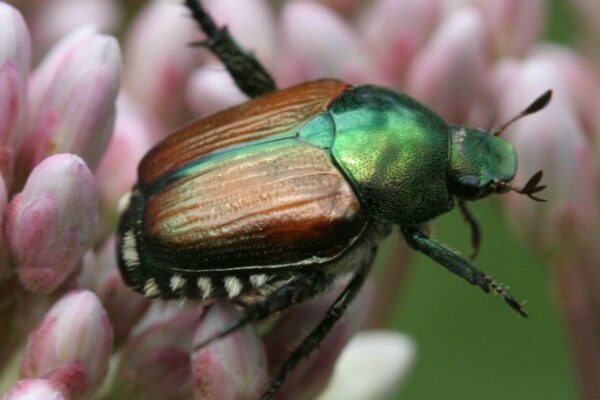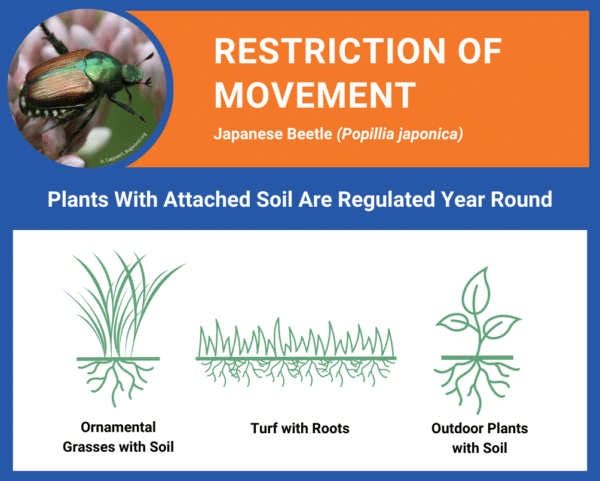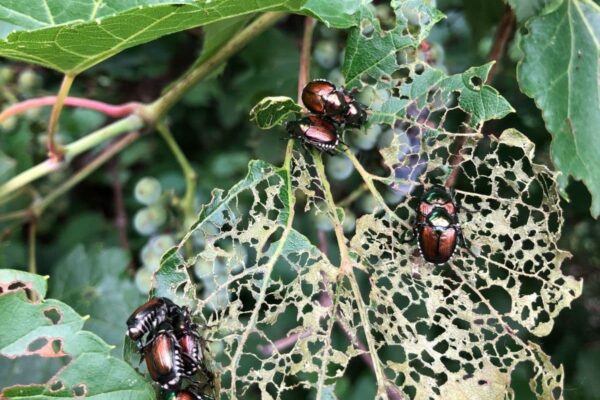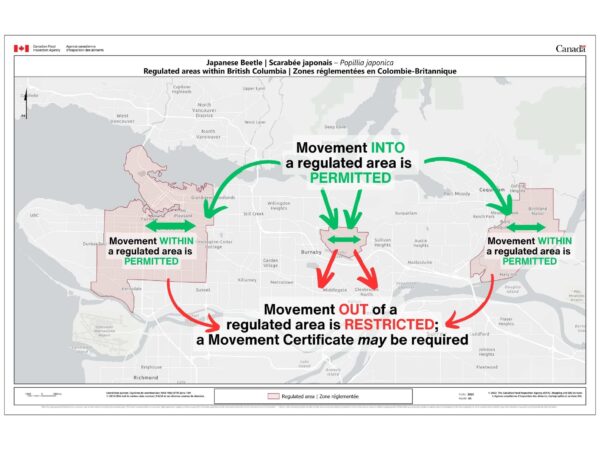Japanese beetle
About This Species
Japanese beetle (Popillia japonica) is an invasive pest in North America and poses a severe threat to ecosystems and industries. Adult Japanese beetles can feed on over 300 species of plants, including many species of agricultural and horticultural importance. Adult beetles damage plants by skeletonizing leaves. Beetle larvae live underground and feed exclusively on the roots of turf and grasses, leaving patches of brown grass in otherwise healthy lawns.
Japanese beetles first established in North America in 1916 in the eastern United States and have since been slowly moving westward. Isolated populations occasionally appear in western states such as Washington and Oregon, though active eradication is underway. It is established in most Eastern provinces except Newfoundland. There are also some parts of Canada where Japanese beetle is unlikely to establish due to factors such as climate conditions. BC is the only province in Canada that is considered a “Japanese beetle pest-free” area.
Japanese beetles were first found in BC in July 2017 in downtown Vancouver. While the population continues to decline in the Vancouver area, trapping results in Burnaby and Port Coquitlam in recent years have led to the expansion of movement control restrictions in Vancouver and Burnaby, and the addition of a regulated area in Port Coquitlam. A revised regulated area later came into effect on May 29, 2023, and includes areas within the cities of Port Coquitlam, Burnaby, and Vancouver, BC.
If P. japonica were to establish in BC, it would have a serious economic impact on our agriculture and turf industries. While Japanese beetles in BC are monitored year-round, adult beetles emerge from hibernation around June, when temperatures consistently reach above 21 °C. The end of their hibernation period marks the beginning of additional restrictions to control their spread.
How to Identify
Adult beetles are around 1 cm long, with a rounded oval shape and a hard shiny green exoskeleton and brown wing covers. The best defining characteristic of this beetle is the six tufts of white hairs running down either sides of the abdomen– no other beetle in BC has this pattern.
Refer to the Japanese Beetle Look-alikes Factsheet to compare the Japanese beetle with similar looking insects found in BC.

Take Action
Report all suspect Japanese beetles to CFIA by calling: 604-292-5742 or by BCPF.Japanese.beetle@inspection.gc.ca (with insect photos when possible)
prevention tips
To reduce the risk of human-assisted movement of Japanese beetle, the Canadian Food Inspection Agency (CFIA) implements movement control restrictions to prohibit the movement of soil and plant material from leaving the regulated area. As the movement of plants with soil or soil-related matter attached is the most high-risk way Japanese beetle spreads to new locations, limiting movement reduces the risk of spread. Restrictions now only apply to the movement of plants with soil or soil-related material attached, which is restricted year-round. Please see the following table for more information on how these restrictions have changed from 2022.
2022 regulated materials
- Movement of plants with soil attached restricted year-round
- Movement of soil out of a Japanese beetle regulated area restricted year-round
- Movement of plants and plant parts with no soil attached out of a Japanese beetle regulated area restricted between June 15 and October 15
2023 regulated materials
- Movement of plants with soil attached restricted year-round

If you live within a regulated area in the Cities of Burnaby, Port Coquitlam, Vancouver, you may be located in a treatment area. If you would like to learn more about having your private property treated please see the province’s JB webpage or contact AgriServiceBC@gov.bc.ca.
For current information on the Cooperative Japanese Beetle Program, please visit the following partner websites:
Canadian Food Inspection Agency (CFIA)
BC Ministry of Agriculture and Food (BC MAF)
REPORT TO PROTECT BC’S BIODIVERSITY

Use the app
Observe and report to protect BC’s biodiversity

Report through this website
Use our form to tell us what you’re seeing and where.




